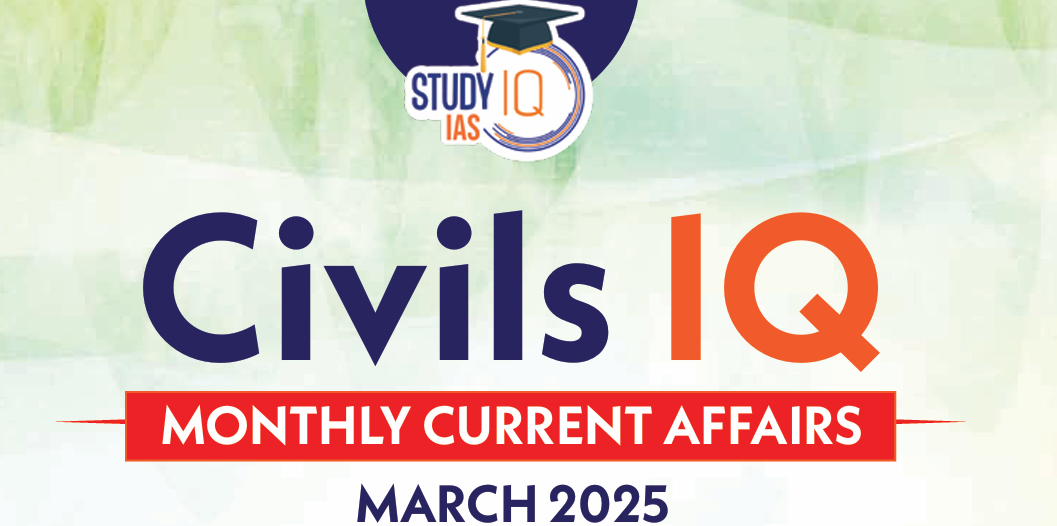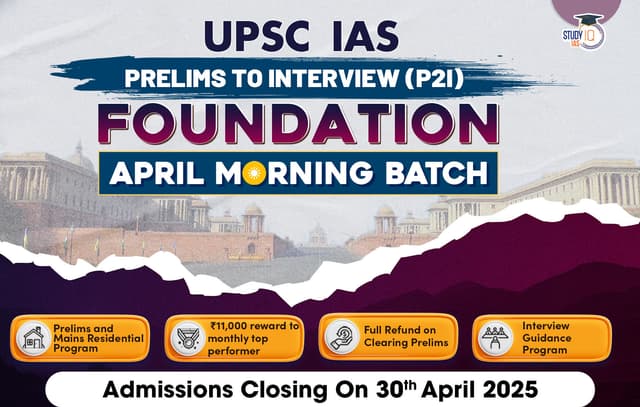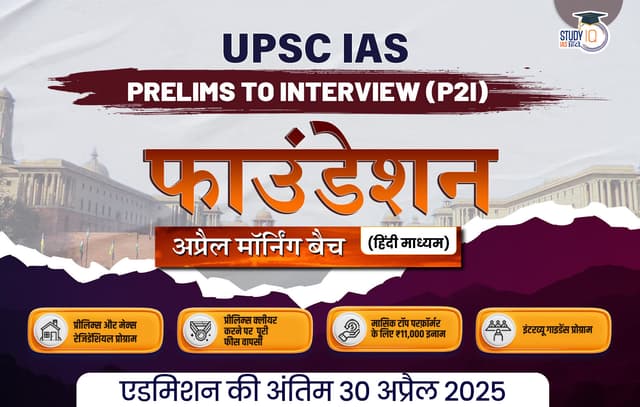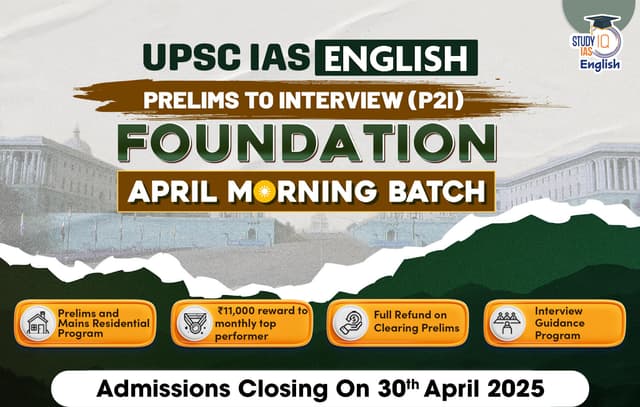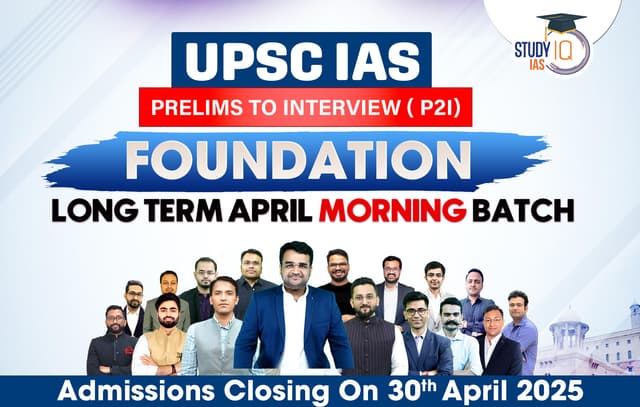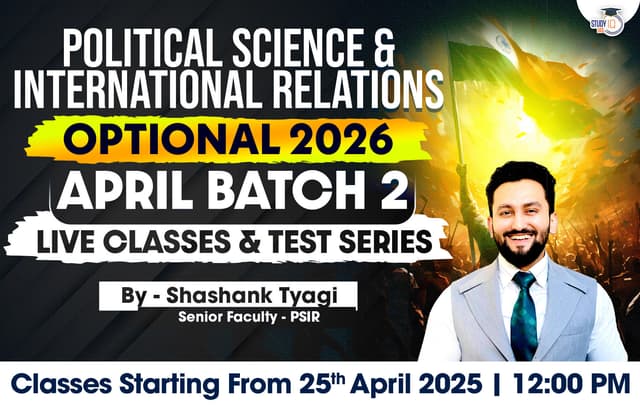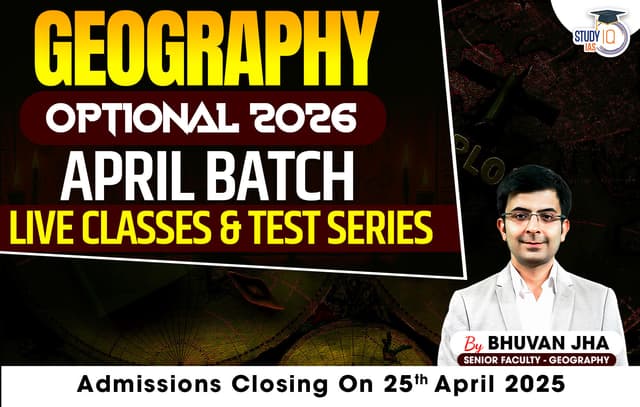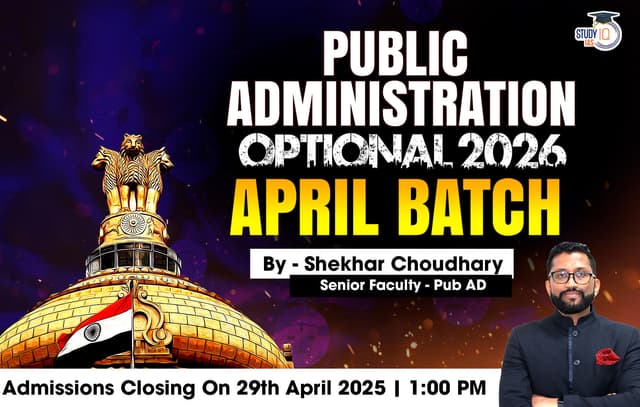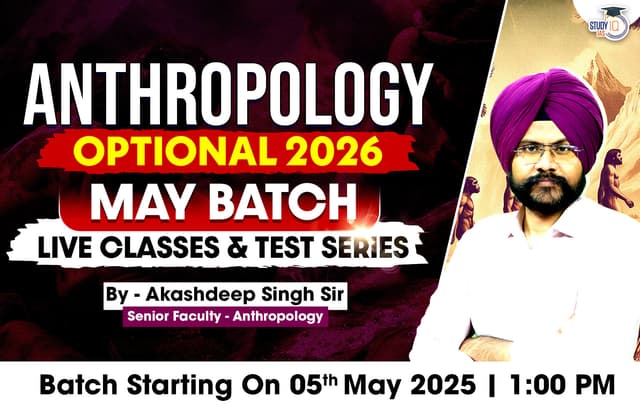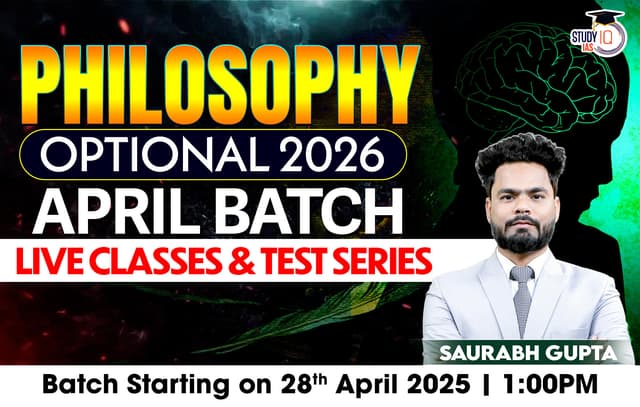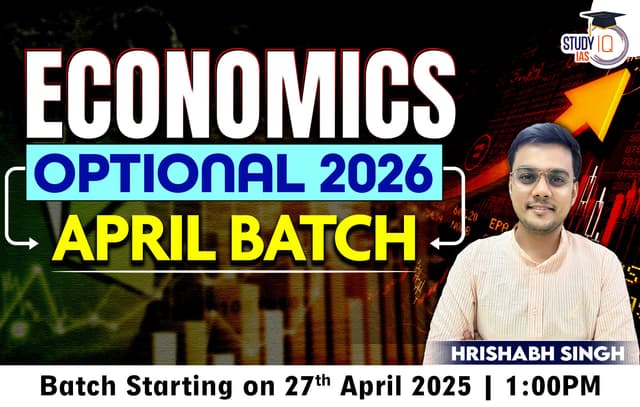Daily Quiz 26 April 2025
Quiz-summary
0 of 5 questions completed
Questions:
- 1
- 2
- 3
- 4
- 5
Information
- Click on – ‘Start Quiz’ button
- Solve Questions
- Click on ‘Next’ button
- Click on ‘Finish Quiz’ button
- Now click on ‘View Questions’ button – here you will see solutions and links.
- The test contains a total of 5 questions.
- Click on the most appropriate option to mark it as your answer.
- You will be awarded Two marks for each correct answer.
- You can change your answer by clicking on some other option.
- A Number list of all questions appears at the top side of the screen.
- You can access the questions in any order by clicking on the question number given on the number list.
- You can use rough sheets while taking the test.
- Do not use calculators, log tables, dictionaries, or any other printed/online reference material during the test.
- Do not click the button “Finish Quiz” before completing the test. A test once submitted cannot be resumed.
You have already completed the quiz before. Hence you can not start it again.
Quiz is loading...
You must sign in or sign up to start the quiz.
You have to finish following quiz, to start this quiz:
- 1
- 2
- 3
- 4
- 5
- Answered
- Review
-
Question 1 of 5
1. Question
1 pointsConsider the following statements regarding India’s nuclear and hydrogen energy initiatives:
- The Government of India has set a target of 100 GW of installed nuclear power capacity by 2047.
- Bharat Small Reactors (BSRs) are 220 MW Pressurized Heavy Water Reactors (PHWRs) developed by NPCIL for industrial captive use.
- Hydrogen produced using nuclear power currently qualifies as “green hydrogen” under India’s official certification scheme.
How many of the above statements are correct?
Correct
Answer: B
Explanation:
- Statement 1 is correct: The Government of India aims to reach 100 GW of nuclear capacity by 2047.
- Statement 2 is correct: Bharat Small Reactors (BSRs) are evolutionary 220 MW PHWRs for captive industrial use, as per NPCIL.
Statement 3 is incorrect: Currently, hydrogen from electrolysers using solar and wind is defined as green; nuclear-produced hydrogen is not included under the current “green” definition. There’s a proposal to change the taxonomy to “low-carbon hydrogen” to include nuclear. Hydrogen qualifies as “green” if its CO2 emissions do not exceed 2 kg CO₂/kg H₂ on average.
Incorrect
Answer: B
Explanation:
- Statement 1 is correct: The Government of India aims to reach 100 GW of nuclear capacity by 2047.
- Statement 2 is correct: Bharat Small Reactors (BSRs) are evolutionary 220 MW PHWRs for captive industrial use, as per NPCIL.
Statement 3 is incorrect: Currently, hydrogen from electrolysers using solar and wind is defined as green; nuclear-produced hydrogen is not included under the current “green” definition. There’s a proposal to change the taxonomy to “low-carbon hydrogen” to include nuclear. Hydrogen qualifies as “green” if its CO2 emissions do not exceed 2 kg CO₂/kg H₂ on average.
-
Question 2 of 5
2. Question
1 pointsConsider the following:
- Ganga Gram
- River-Front Development
- Industrial Effluent Monitoring
- Sewerage Treatment Infrastructure
- Afforestation
How many of the above are the Main pillars of the Namami Gange Programme?
Correct
Answer: D
Explanation:
- Option D is correct: Namami Gange Programme’, is an Integrated Conservation Mission, approved as ‘Flagship Programme’ by the Union Government in June 2014 with budget outlay of Rs.20,000 Crore to accomplish the twin objectives of effective abatement of pollution, conservation and rejuvenation of National River Ganga. The Main pillars of the Namami Gange Programme are:
- Ganga Gram
- River-Front Development
- Industrial Effluent Monitoring
- Sewerage Treatment Infrastructure
- Afforestation
- Bio-Diversity
- River-Surface Cleaning
- Bio-Diversity
Incorrect
Answer: D
Explanation:
- Option D is correct: Namami Gange Programme’, is an Integrated Conservation Mission, approved as ‘Flagship Programme’ by the Union Government in June 2014 with budget outlay of Rs.20,000 Crore to accomplish the twin objectives of effective abatement of pollution, conservation and rejuvenation of National River Ganga. The Main pillars of the Namami Gange Programme are:
- Ganga Gram
- River-Front Development
- Industrial Effluent Monitoring
- Sewerage Treatment Infrastructure
- Afforestation
- Bio-Diversity
- River-Surface Cleaning
- Bio-Diversity
-
Question 3 of 5
3. Question
1 pointsConsider the following statements regarding Type 5 Diabetes:
- It is caused by chronic exposure to malnourishment leading to impaired pancreatic development.
- People with Type 5 diabetes are insulin resistant but not insulin deficient.
- The condition can be managed using oral medication and insulin injections.
How many of the above statements are correct?
Correct
Answer: B
Explanation:
- According to International Diabetes Federation, type 5 diabetes affects more than 20 to 25 million people in the world, primarily in Africa and Asia. Type 5 diabetes is caused by elevated levels of insulin deficiency and poor metabolic control, and it affects lean and malnourished teens and young adults in low- and middle-income countries.
- Statement 1 is correct: Unlike type 1 and type 2 diabetes, type 5 diabetes stems from chronic exposure to severe malnourishment, especially during the formative years of childhood and adolescence. It is believed to stem from impaired pancreatic development due to long-term nutrient deficiencies.
- Statement 2 is incorrect: People with Type 5 diabetes are not insulin resistant, but insulin deficient.
- Statement 3 is correct: It can be managed with oral medication and insulin injections.
Incorrect
Answer: B
Explanation:
- According to International Diabetes Federation, type 5 diabetes affects more than 20 to 25 million people in the world, primarily in Africa and Asia. Type 5 diabetes is caused by elevated levels of insulin deficiency and poor metabolic control, and it affects lean and malnourished teens and young adults in low- and middle-income countries.
- Statement 1 is correct: Unlike type 1 and type 2 diabetes, type 5 diabetes stems from chronic exposure to severe malnourishment, especially during the formative years of childhood and adolescence. It is believed to stem from impaired pancreatic development due to long-term nutrient deficiencies.
- Statement 2 is incorrect: People with Type 5 diabetes are not insulin resistant, but insulin deficient.
- Statement 3 is correct: It can be managed with oral medication and insulin injections.
-
Question 4 of 5
4. Question
1 pointsWith reference to the appointment of the Consider the following statements regarding the appointment of a Judge to the Supreme Court of India:
- The Chief Justice of India forms his opinion in consultation with a collegium consisting of the four seniormost puisne Judges of the Supreme Court.
- The successor Chief Justice of India, even if not among the four seniormost puisne Judges, is excluded from the collegium to avoid bias.
- After final recommendation by the Chief Justice of India, the Union Minister of Law forwards the proposal to the Prime Minister who advises the President for appointment.
How many of the above statements are correct?
Correct
Answer: B
Explanation:
- Statements 1 and 3 are correct and statement 2 is not correct: Whenever a vacancy is expected to arise in the office of a Judge of the Supreme Court, the Chief Justice of India will initiate proposal and forward his recommendation to the Union Minister of Law, Justice and Company Affairs to fill up the vacancy.
- The opinion of the Chief Justice of India for appointment of a Judge of the Supreme Court should be formed in consultation with a collegium of the four seniormost puisne Judges of the Supreme Court. If the successor Chief Justice of India is not one of the four seniormost puisne Judges, he would be made part of the collegium as he should have a hand in selection of Judges who will function during his term as Chief Justice of India.
- The Chief Justice of India would ascertain the views of the seniormost Judge in the Supreme Court, who hails from the High Court from where the person recommended comes, but if he does not have any knowledge of his merits and demerits, the next seniormost Judge in the Supreme Court from that High Court should be consulted.
- The requirement of consultation with a Judge of the Supreme Court would not be confined to that Judge only who has that High Court as a parent High Court and, therefore, would not exclude Judges who have, on transfer, occupied the office of a Judge or Chief Justice of that High Court.
- The opinion of members of the collegium in respect of each of the recommendations as well as the seniormost Judge in the Supreme Court from the High Court, from which a prospective candidate comes, would be made in writing and the Chief Justice of India, in all cases, must transmit his opinion as also the opinion of all concerned to the Government of India as part of record. If the Chief Justice of India or the other members of the Collegium elicit views, particularly those from the non-Judges, the consultation need not be in writing but he, who elicits the opinion, should make a memorandum thereof and its substance in general terms which should be conveyed to the Government of India.
- After receipt of the final recommendation of the Chief Justice of India, the Union Minister of Law, Justice and Company Affairs will put up the recommendations to the Prime Minister who will advise the President in the matter of appointment.
- As soon as the appointment is approved, the Secretary to the Government of India in the Department of Justice will inform the Chief Justice of India and obtain from the person selected a certificate of physical fitness signed by a Civil Surgeon or a District Medical Officer. The Medical Certificate is to be obtained from all persons selected for appointment whether they are at the time of appointment in the service of the State or not. The certificate should be in the form annexed.
As soon as the warrant of appointment is signed by the President, the Secretary to the Government of India in the Department of Justice will announce the appointment and issue the necessary notification in the Gazette of India.
Incorrect
Answer: B
Explanation:
- Statements 1 and 3 are correct and statement 2 is not correct: Whenever a vacancy is expected to arise in the office of a Judge of the Supreme Court, the Chief Justice of India will initiate proposal and forward his recommendation to the Union Minister of Law, Justice and Company Affairs to fill up the vacancy.
- The opinion of the Chief Justice of India for appointment of a Judge of the Supreme Court should be formed in consultation with a collegium of the four seniormost puisne Judges of the Supreme Court. If the successor Chief Justice of India is not one of the four seniormost puisne Judges, he would be made part of the collegium as he should have a hand in selection of Judges who will function during his term as Chief Justice of India.
- The Chief Justice of India would ascertain the views of the seniormost Judge in the Supreme Court, who hails from the High Court from where the person recommended comes, but if he does not have any knowledge of his merits and demerits, the next seniormost Judge in the Supreme Court from that High Court should be consulted.
- The requirement of consultation with a Judge of the Supreme Court would not be confined to that Judge only who has that High Court as a parent High Court and, therefore, would not exclude Judges who have, on transfer, occupied the office of a Judge or Chief Justice of that High Court.
- The opinion of members of the collegium in respect of each of the recommendations as well as the seniormost Judge in the Supreme Court from the High Court, from which a prospective candidate comes, would be made in writing and the Chief Justice of India, in all cases, must transmit his opinion as also the opinion of all concerned to the Government of India as part of record. If the Chief Justice of India or the other members of the Collegium elicit views, particularly those from the non-Judges, the consultation need not be in writing but he, who elicits the opinion, should make a memorandum thereof and its substance in general terms which should be conveyed to the Government of India.
- After receipt of the final recommendation of the Chief Justice of India, the Union Minister of Law, Justice and Company Affairs will put up the recommendations to the Prime Minister who will advise the President in the matter of appointment.
- As soon as the appointment is approved, the Secretary to the Government of India in the Department of Justice will inform the Chief Justice of India and obtain from the person selected a certificate of physical fitness signed by a Civil Surgeon or a District Medical Officer. The Medical Certificate is to be obtained from all persons selected for appointment whether they are at the time of appointment in the service of the State or not. The certificate should be in the form annexed.
As soon as the warrant of appointment is signed by the President, the Secretary to the Government of India in the Department of Justice will announce the appointment and issue the necessary notification in the Gazette of India.
-
Question 5 of 5
5. Question
1 points“Dustlik” is a joint military exercise conducted between India and which of the following countries?
Correct
Answer: B
Explanation:
- Option B is correct: Exercise Dustlik is a bilateral military exercise conducted between the Indian Army and the Uzbekistan Army.
The theme of the exercise in 2025 will be based on the theme of Joint Multi-Domain Sub-Conventional operations in a Semi-Urban Scenario. It will focus on responding to a terrorist action involving the capture of a defined territory.
Incorrect
Answer: B
Explanation:
- Option B is correct: Exercise Dustlik is a bilateral military exercise conducted between the Indian Army and the Uzbekistan Army.
The theme of the exercise in 2025 will be based on the theme of Joint Multi-Domain Sub-Conventional operations in a Semi-Urban Scenario. It will focus on responding to a terrorist action involving the capture of a defined territory.
Results
0 of 5 questions answered correctly
Your time:
Time has elapsed
You have reached 0 of 0 points, (0)
| Average score |
|
| Your score |
|
Categories
- Not categorized 0%
| Pos. | Name | Entered on | Points | Result |
|---|---|---|---|---|
| Table is loading | ||||
| No data available | ||||
Sharing is caring!


 Daily Quiz 24 April 2025
Daily Quiz 24 April 2025
 Daily Quiz 21 April 2024
Daily Quiz 21 April 2024
